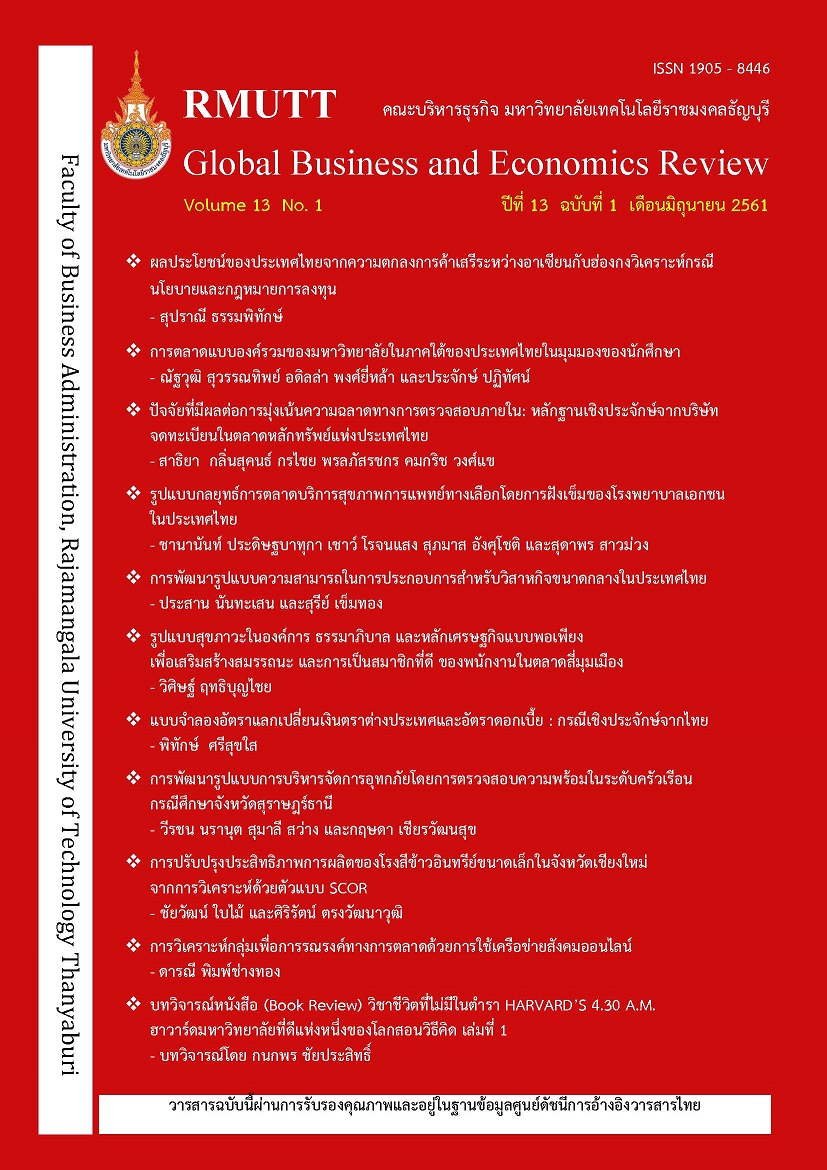CLUSTER ANALYSIS FOR MARKETING CAMPAIGN USING SOCIAL NETWORK
Keywords:
Cluster Analysis, Social Media, Marketing CampaignAbstract
The objectives of this research were to 1) find the most important factors influencing purchasing merchandise or using services that are advertised online, 2) identify the number of clusters and the clusters characteristics that purchase merchandise or use services after seeing online advertising in social media. The sample group was people who used to purchase merchandise or used services through online social media such as Facebook, Line, and Instagram. The questionnaires were used to collect data for 400 samples using Convenience Sampling Method. Statistics used to analyze data were percentages, frequencies, correlation, and Cross Industry Standard Process for Data Mining (CRISP – DM) using Operator k-Mean. Data were analyzed using statistical software and Rapid Miner Studio 6. The research results found that the most important factors influencing purchasing merchandise or using services that are advertised online were saving information for further consideration, the text, image, and clip advertising on social media, satisfaction with merchandise or service, and interesting price. For clusters characteristics, the findings indicated two clusters: product conscious cluster and price conscious cluster. Although these two groups had clearly different characteristics, they were similar on the influence of online advertising in saving information for further consideration and interest in the ads once seeing text, image and clip advertising on social media. Up-todate methods and technology innovation should be considered when creating ads online to attract more shoppers and create more shopper’s involvement that would lead to increased purchasing.
References
ดนัย ปัตตพงษ.์ (2559). Statistics talk: cluster analysis, knowledge management. Retrieved from http://it.nation.ac.th/faculty/danai/showinfo_st.php
Balan, S., & Rege, J. (2017). Mining for social media: usage patterns of small business. Business Systems Research, 8(1), 43 -50.
Boonjing, V., & Pimchangthong, D. (2017). Data mining for customers’ positive reaction to advertising in social media. Proceedings of the Federated Conference on Computer Science and Information Systems, 945-948.
Bradlow, E. T., Gangwar, M., Kopalle, P., & Voleti, S. (2017). The role of big data and predictive analytics in retailing. Journal of Retailing, 93(1), 79-85.
Everitt, B., Landau S., Morven Leese M., & Stahl, D. (2011). Cluster analysis (5th ed.). UK.: John Wiley and Sons.
Han, J. & Kamber, M. (2006). Data mining concepts and techniques (2nd ed.). United States of America: Morgan Kaufmann Publishers.
Jara, A. J., Parra, M. C., & Skarmeta, A. F. (2013). Participative marketing: extending social media marketing through the identification and interaction capabilities from the Internet of things. Personal and Ubiquitous Computing, 1-15, doi: 10.1007/s00779-013-0714-7.
Rajeev, V. & Jyoti, V. (2012). The role of motivation as a moderator of the job demandburnout-performance relationship among service employees in a social marketing campaign, Decision, 39(3), 68-85.
Rouse, M. (2009). Microblogging. Retrieved from https://searchmobilecomputing.techtarget.com /definition /microblogging
Statista. (2018). Brands on social media - statistics & facts, the statistics portal. Retrieved from https://www.statista.com/topics/2057/brands-on-social-media/
Tuten, T. L., & Solomon, M. R. (2013). Social media marketing. New Jersey: Prentice Hall.
Whiting, A., & Deshpande, A. (2016). Toward greater understanding of social media marketing: a review, Journal of Applied Business and Economics, 18(4), 82-91.
Yazdanparast, A., Joseph, M., & Qureshi, A. (2015). An Investigation of facebook boredom phenomenon among college students. Young Consumers, 16(4), 468-480.
Downloads
Published
How to Cite
Issue
Section
License
The articles published in this journal are the intellectual property of their respective authors.
The views and opinions expressed in each article are solely those of the individual authors and do not reflect the positions of Rajamangala University of Technology Thanyaburi or any of its faculty members. All components and content of each article are the sole responsibility of the respective authors. In the event of any errors, the authors shall bear full responsibility for their own work.








